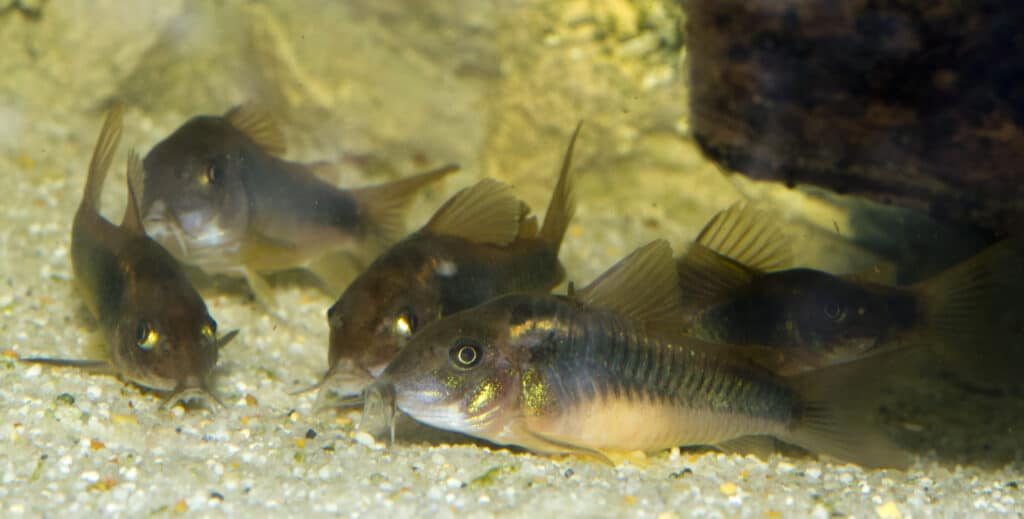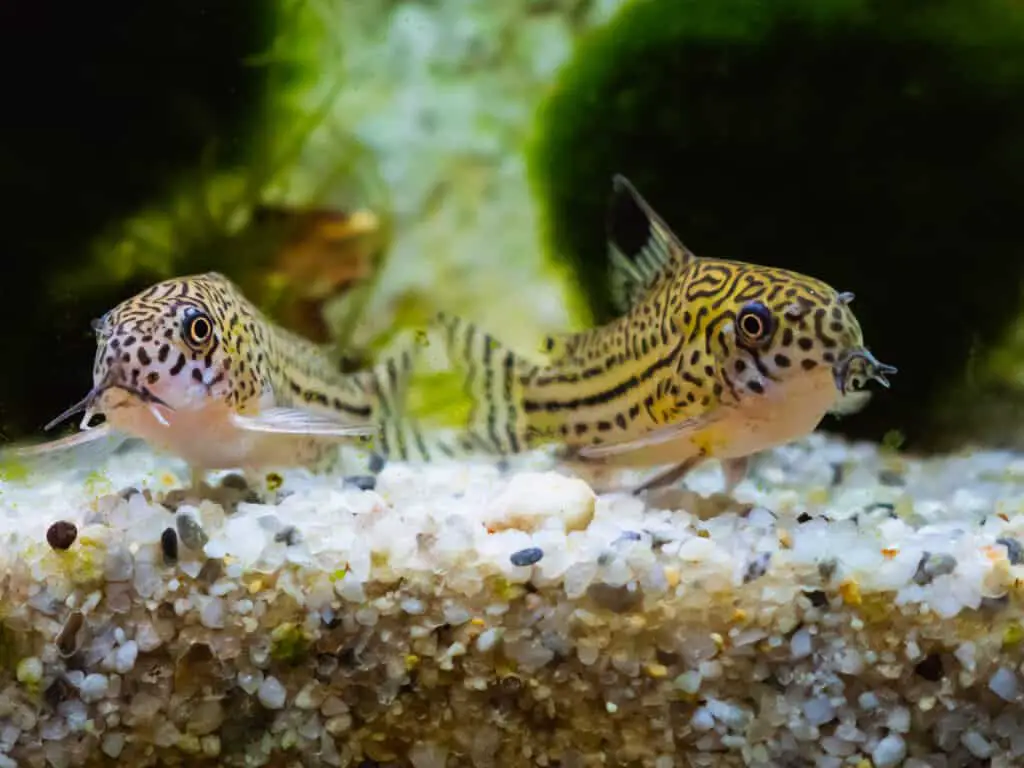
Corydoras and Freshwater Shrimp are among aquarium hobbyist favorites when wanting to have bottom dwellers in their tanks.
But a question is sometimes raised on whether these two species are compatible with each other and whether should they be kept together in the same tank.
In general, Corydoras and Shrimp are compatible species and can be kept together in the same tank. Both require similar water parameters and can eat many of the same things. With this pairing tanks with more bottom surface area are recommended because they are both bottom dwellers and spend most of their time on the substrate.
Though they are compatible in technical terms, there are things to consider based on the particular type of shrimp and corydoras being considered. Let’s take a look at the various requirements, including breeding considerations, feeding, and environment needs for each to help determine why these two aquatic species can be together, and if they’re right for your tank.
Environment Considerations When Combining Corydoras and Shrimp
One of the biggest considerations to be made when combining corydoras with freshwater shrimp is the dimensions of your tank.
Cramped quarters for any fish species can lead to stress and health issues, as well as making it harder to keep water parameters in the recommended amounts.
This is even more important when adding two species that will inhabit mostly the same levels in the aquarium, in this case, the bottom.
Tanks that have more bottom surface area, typically that are shorter in height and longer in depth and width will provide the best environment for housing multiple types of bottom dwellers.
It will also be important to provide multiple spaces for hiding spots, this will allow the shrimp to be more at ease and comfortable.
Though corydoras are in general peaceful community fish, their size could cause the smaller shrimp to be more timid, and adding hiding spots will help lower stress.
This is especially true during times of feeding.

Corydoras and Freshwater Shrimp Water Requirements
When discussing water parameters, there are several key data points to consider.
pH levels, GH (General Hardness), kH (Carbonate Hardness), and Temperature. Nitrate, Ammonia, and Nitrite should also be monitored, but for all of these species, they should fall in the same general range of 0 ppm for Ammonia and Nitrites, and less than 10 ppm for Nitrates.
When discussing shrimp two main types in the fish-keeping hobby are normally considered. These are the Neocaridina and Caridina Shrimp, both are of similar size, but their water parameters will vary. If you would like to go into more depth on these two differences, read my article here.
For Neocaridina shrimp, which would include cherry shrimp, you would look for a gH of 4 to 8, kH of 2 to 10, pH between 6.2 and 8, and temperatures in the range of 65F to 85F.
For Caridina shrimp, which would include crystal shrimp, you are looking for a gH of 4 to 6, kH of 0 to 1, pH between 5.8 and 6.8, and temperatures in the range of 62F to 76F.
For Corydoras, there are a vast amount of species available to choose from, however for the majority of these species, these are the ranges you should aim for, some may be closer to one end of the spectrum over the other, but they should all still be able to live in these ranges.
It would be best if you were aiming for gH of 5 to 10, kH of 3 to 10, pH between 7 and 7.8, and temperatures in the range of 70F to 78F.
From these numbers, Neocaridina shrimp would be considered better-suited tankmates with corydoras due to a closer resemblance in tank parameters, however, Caridina shrimp could still be considered.
| Neocaridina Shrimp | Caridina Shrimp | Corydoras | |
| GH (General Hardness) | 4-8 | 4-6 | 5-10 |
| kH (Carbonate Hardness) | 2-10 | 0-1 | 3-10 |
| pH | 6.2 – 8.0 | 5.8 – 6.8 | 7.0 – 7.8 |
| Temperature | 65F – 85F | 62F – 76F | 70F – 78F |
Dietary Needs for Corydoras and Freshwater Shrimp
The dietary needs of both shrimp and corydoras are very similar, which is one of the reasons they can make an ideal pairing and can be put together in a tank.
Both are bottom feeders that will scavenge for leftover food in the substrate.
However, they can also be given food directly without much issue.
Because they eat in similar fashions, there can be a case made that this could lead to competition for food, but this can be limited by giving more food, and also spreading the given food over the entire tank, instead of having it all clump together in the same location.
This will give space for both the shrimp and corydoras to eat without worrying about each other.
It is also vital to give a variety of food sources, both will also eat anything given, so don’t be afraid to give different types of food which will be beneficial for both.
Sinking pellets and things like algae wafers or specialized shrimp food can help make sure that the food given directly to them will reach the bottom of the tank, and in areas where they will be able to easily reach it.

Considerations to Make If You Want to Breed
You should also be asking yourself what the goal of your tank is.
Is this tank going to be a showcase tank, where you want to come in and watch an underwater ecosystem at work, or is it something where you would like to breed and increase your population?
If your goal is to breed your corydoras, there isn’t much concern in having shrimp in your tank, as the little damage they may do, as in eating the eggs, will most likely be very minimal, and unharmful to an increase in population.
However, a popular goal of having shrimp in a tank is to create a colony, starting with a small group of shrimp, and watching their population grow in your tank.
Though there are some benefits to having a fish presence in a tank of shrimp, for breeding purposes, it is generally recommended to keep it as a shrimp-only tank.
You can also look at having two tanks, where one is for your shrimp colony, and another is a showcase where you can on occasion move some of your shrimp to the showcase tank.
If you are only able to have a single tank, and still have corydoras together with your shrimp, while trying to breed the shrimp, the best plan is to look at smaller species of corydoras.
If larger corydoras species are wanted, the best plan is to have a very densely planted tank, to give the baby shrimp ample area to hide, make sure your corydoras are well fed, and also realize that you may lose some of your baby shrimp from being eaten by the corydoras.
Final Thoughts and Some Recommendations
Though there may be some things to consider, you can have corydoras and shrimp live in the same tank.
The best thing to have when combining species is a well-planned tank environment, where everything is considered to reduce surprises and ensure the best experience is had.
Ample space, the correct amount of feeding, and monitoring your tank for any changes, or possible problems will all help in the successful coexistence of these two fantastic species.
Challenges will always exist with any tank, but having a harmonious tank that has shrimp and corydoras is achievable with the right knowledge and care.
